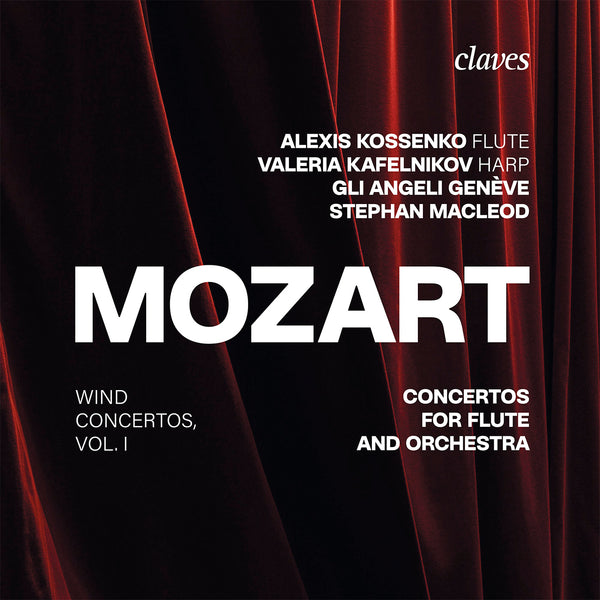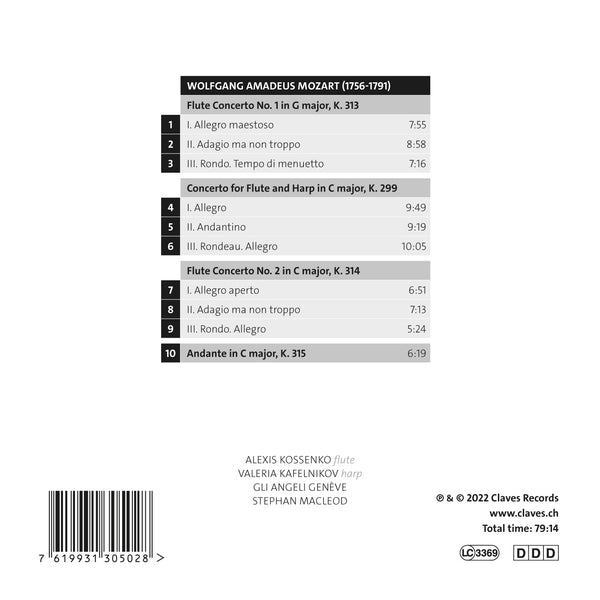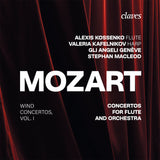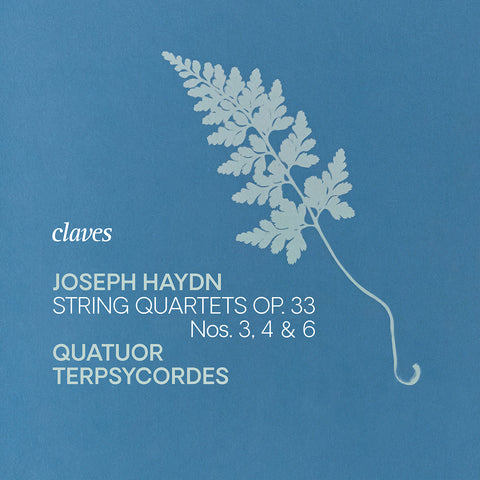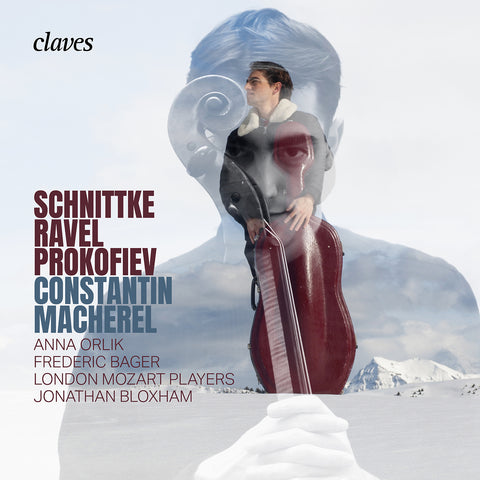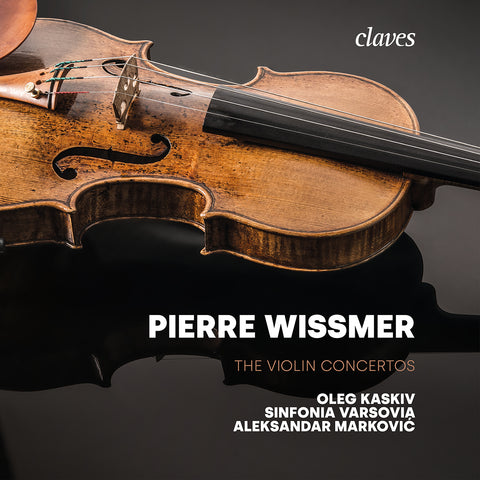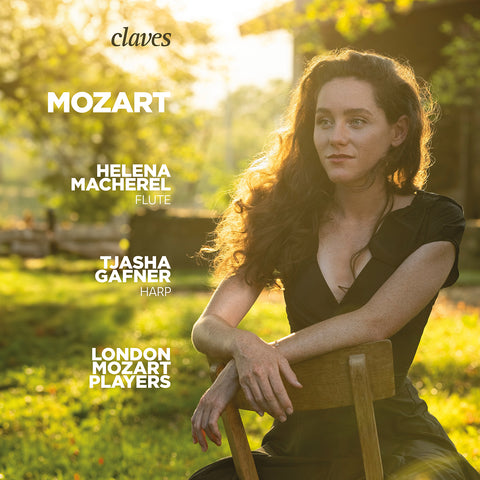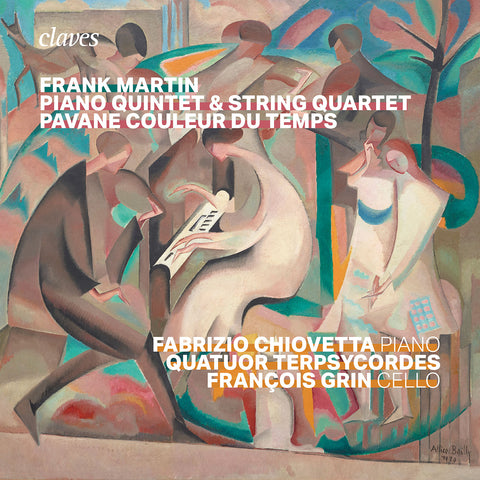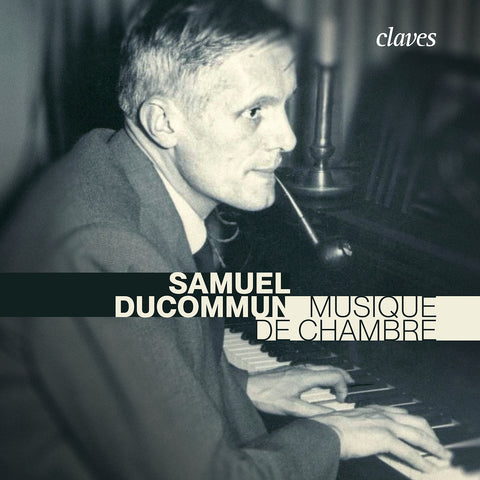(2022) Mozart: Concertos for flute and orchestra
Category(ies): Concerto Orchestra Repertoire
Instrument(s): Bassoon Cello Double bass Flute Harp Oboe Violin
Vocal(s): Alto
Main Composer: Wolfgang Amadeus Mozart
Ensemble: Gli Angeli Genève
Conductor: Stephan MacLeod
CD set: 1
Catalog N°:
CD 3050
Release: 07.10.2022
EAN/UPC: 7619931305028
This album is now on repressing. Pre-order it at a special price now.
CHF 18.50
This album is no longer available on CD.
This album has not been released yet. Pre-order it from now.
CHF 18.50
This album is no longer available on CD.
CHF 18.50
VAT included for Switzerland & UE
Free shipping
This album is no longer available on CD.
VAT included for Switzerland & UE
Free shipping
This album is now on repressing. Pre-order it at a special price now.
CHF 18.50
This album is no longer available on CD.
This album has not been released yet.
Pre-order it at a special price now.
CHF 18.50
This album is no longer available on CD.
CHF 18.50
This album is no longer available on CD.
MOZART: CONCERTOS FOR FLUTE AND ORCHESTRA
ENCHANTED FLUTE
If Mozart gave the concerto of his time its ultimate shape, it is because he transferred to it all the characteristics of the opera aria, giving the cantabile – which he often mentions in his correspondence – most significant importance and transforming the vocal virtuosic runs instrumental figurations. The soloist is a character whose rhetoric gives the orchestral material presented in the introduction a deeper, more intimate and more sensitive dimension. This constitutes the raison d’être of the relationship between the individual and the group, between the solos and the tuttis.
Mozart always had in mind the musician for whom the work was written, whether it was an aria or a concerto. He then tailored a suit to measure, as he said (in his piano concertos, he referred to himself, hence the depth and complexity of what is expressed in these works). For a soloist with a virtuoso technique, he would compose highly challenging passages; for someone less assured, he would deliver a more accessible score. Therefore, the last of the four horn concertos written for the famous Joseph Leutgeb is far less demanding than the previous ones since the ageing soloist could no longer play the highest notes. Similarly, the flute part of the Flute and Harp Concerto uses the low notes that were the uniqueness of the instrument used by the Count of Guînes, who commissioned the piece (the notes D flat and C, now found on modern flutes).
The superiority of Mozart’s concertos over those of his contemporaries, including Haydn, lies in the subtle combination of the form’s rigidity and the dramatisation of the musical discourse. Mozart had already experimented with this in the opera seria arias and managed to create tensions and progressions within a static form. Therefore, he did not try to innovate at a formal: his concertos are mostly built on the same pattern. But their content is very rich, and this richness grows according to its development. It largely stems from the composer’s melodic genius, which allowed him to link several characteristic ideas in an organic continuity as if each one flowed from the previous one. It is also due to the fact that the orchestra does not merely accompany the soloist but fully participates in the construction of the musical discourse. [..]
THE SEARCH FOR INDEPENDENCE
Playing Mozart’s concertos poses the same problem for a flutist as Bach’s sonatas and partitas do for a violinist or his suites for a cellist. This problem is encountered with masterpieces that entered our repertoire too early; when we are confronted with the admirable before the ordinary or when we are taught the exception before the rule. How can we find the distance that will allow us to offer a personal reading? How can we take an objective look at what is already familiar? How can we judge and appreciate as an adult what we have been fed since our earliest childhood? How can we question the precepts taught us in our early years of study? How, finally, to escape from the prison of tradition?
I have never been driven by the desire to do something different at all costs, but by the desire to understand what the work has to tell us. And it is not so easy to reach a stage of lucidity with the “pillars of the repertoire”. Sometimes you have to turn your back on them for a while to rediscover them with fresh eyes, with a virgin heart, to see and feel them as they are and not as we have been taught to consider them. For a long time, I loved Mozart and considered him a genius, simply because I had been taught to love him and consider him as such! Then one day, something clicked; a sudden awareness, lived and felt, of the uniqueness of his genius; a love that has only grown, and above all a sudden discovery of the dramatic potential of his music, not in any way limited to his operas. Each of his works is in fact an opera in miniature, a theater of the soul, and his flute concertos are no exception. This is the angle from which we have approached them, with their share of intrigues, feelings, comic moments, and coups de théâtre! And, much more than the performance of a soloist with orchestral accompaniment, we wanted to bring to light a compelling dialogue, between an operatic character who would be the soloist and an orchestra that is both a setting and an actor, sometimes playing a single character, sometimes a crowd. [..]
ALEXIS KOSSENKO, flute
Born in Nice in 1977, Alexis Kossenko now leads a career both as a conductor and a flautist. With his deep knowledge of all the historical forms of his instrument, he plays the modern flute (he graduated́ from the CNSM in Paris in Alain Marion’s class and won the 2000 Rampal Competition) as well as the baroque, classical and romantic flutes, and the recorder. He performs as a soloist with numerous orchestras and ensembles including the Deutsche Symphonie-Orchester Berlin, the Stockholm Philharmonic Orchestra, Concerto Copenhagen, Ensemble Matheus, Philharmonie der Nationen, La Grande Écurie et la Chambre du Roy, Stradivaria, Barokksolistene, B’Rock, Le Cercle de l’Harmonie, La Chambre Philharmonique, Modo Antiquo, Le Concert Lorrain, Holland Baroque Society, Helsinki Baroque Orchestra, Ensemble Resonanz and Gli Angeli Genève, in a repertoire ranging from Vivaldi to Khachaturian. He has performed or conducted at the Berlin, Warsaw and Stockholm Philharmonics, the Wigmore Hall and the Royal Albert Hall in London, the Mozarteum in Salzburg, the Théâtre des Champs-Élysées and the Salle Gaveau in Paris, the Tonhalle in Zurich, the Concertgebouw in Bruges and Amsterdam and the Royal Opera House in Copenhagen. [..]
VALERIA KAFELNIKOV, harp
Valeria Kafelnikov trained in Russia and then in France, where she obtained the First prize in Isabelle Moretti’s class and the Aptitude certificate in the Pedagogy department of the Paris Conservatoire (CNSMDP). She then perfected her skills with Fabrice Pierre at the Lyon Conservatoire (CNSMDL). She also attended masterclasses with György Kurtág and Pierre Boulez before taking part in the Verbier Youth Orchestra as first harp under James Levine, Zubin Mehta and Wolfgang Sawallisch.
In 2018, Valeria Kafelnikov joined the Ensemble Intercontemporain. This appointment pursues an important commission and creation work she had already undertaken in collaboration with the Quatuor Béla, within the Trio Lisbeth Project or with ensembles like Alternance or Court-Circuit. She has thus established privileged connections with contemporary composers such as Frédéric Pattar, Vincent Bouchot, Ernest H. Papier and Aurélio Edler-Copes. Valeria Kafelnikov is also the principal harpist of the orchestra Les Siècles conducted by François-Xavier Roth. She is most interested in the history of interpretation and historical instruments and performs within her recitals on various instruments such as the 18th-century single-action harp, the late 19th-century Érard harp and the modern harp. [..]
STEPHAN MACLEOD, direction
Geneva-born Stephan MacLeod is a singer and conductor. He now conducts between 40 and 50 concerts a year worldwide, including an increasing number of appearances as guest conductor with “modern” orchestras. He also happily pursues his career as a singer and is a vocal teacher at the Haute Ecole de Musique de Lausanne (HEMU). [..]
As a Lied and melody lover, Stephan MacLeod gives numerous recitals. He has also appeared on opera stages, notably at La Monnaie in Brussel, La Fenice in Venice, and in opera houses in Geneva, Toulouse, Nîmes, Bordeaux, Cologne, Potsdam, Freiburg, Gerona, etc. Alongside his singing career, he has also been conducting regularly since 2005 and is the founder of Gli Angeli Genève, an ensemble that has gained significant international recognition in recent years.
Since 2013, Stephan MacLeod is a vocal teacher at the Haute Ecole de Musique de Lausanne. He divides his time between family, teaching, singing commitments, his ensemble and conducting – particularly Bach’s music. His discography includes over 100 CDs, many of which have been awarded.
GLI ANGELI GENÈVE
Gli Angeli Genève was founded in 2005 by Stephan MacLeod. This ensemble of variable size plays on period instruments (or copies thereof) and comprises musicians who pursue a career in baroque music but are not active in this field only: they do not solely play early music. Their eclecticism guarantees the vitality of their enthusiasm. It is also a driving force behind their curiosity.
From the very beginning of its musical adventure – solely focused for several years on the concert performance of the complete Bach Cantatas, with three concerts per season in Geneva – Gli Angeli Genève has been a meeting place for some of the most famous singers and instrumentalists on the international Baroque scene and young graduates of the Basel, Lyon, Lausanne and Geneva music schools. [..]
Gli Angeli Genève’s first recording for Claves, Sacred Music of the 17th Century in Wroclaw, won the 2019 ICMA Award for the best recording of the year of baroque vocal music. In addition, Johann Sebastian Bach’s St. Matthew Passion received enthusiastic acclaim from audiences and critics, both in Switzerland and worldwide. Gli Angeli Genève’s recordings also include Bach’s Mass in B minor, nominated in 2022 for an ICMA Award ; Bach’s Bass Cantatas, released in April 2022 ; and Antoine Reicha’s rarely performed Symphonies Concertantes, with soloists Christophe Coin, Davit Melkonyan, Chouchane Siranossian and Alexis Kossenko.
DISTRIBUTION & WORKS
WOLFGANG AMADEUS MOZART
Concertos for flute and orchestra
K. 313 · 314 · 315 · 299
Alexis Kossenko, flûte
Valeria Kafelnikov, harpe (K. 299)
***
Eva Saladin, Adrien Carré, Claire Foltzer, Jonathan Nubel, Coline Ormond, Nadia Rigolet, violons 1
Sonoko Asabuki, Stéphanie Erös, Angelina Holzhofer, Murielle Pfister, Xavier Sichel, violons 2
Deirdre Dowling, Caroline Cohen-Adad, Bettina Ruchti, Martine Schnorhk, altos
Felix Knecht, Oleguer Aymami, Hager Hanana, violoncelles
Michaël Chanu, Clena Stein, contrebasses
Sarah Van Cornewal, Sara Boesch, flûtes (K. 313)
Emmanuel Laporte, Claire Thomas, hautbois
Philippe Miqueu, Carles Cristobal, bassons
Antoine Dreyfuss, Alessandro Orlando, cors
Stephan MacLeod, direction
***
K. 313 et 315: flûte de Martin Wenner d’après August Grenser (1790) a 1 clé, en grenadille
K. 314: flûte de Martin Wenner d’après August Grenser (1790) a 1 clé, en ébène
K. 299: flûte de Martin Wenner d’après August Grenser (1790) a 8 clés, en grenadille harpe à simple mouvement Etienne Chaillot, fin du 18e siècle
***
Concertos K. 313 et K. 314 & Andante K. 315
Cadences improvisées ou librement inspirées des exemples de Rachel Brown et Konrad Hünteler (Bärenreiter).
Concerto pour flûte et harpe K. 299
Cadences de Sylvain Blassel (éditions Harposphère), librement adaptées
REVIEWS
« Mozart’s concertos for flute and for flute and harp are among the most beloved and most frequently recorded works of his orchestral repertoire. So what makes this new recording noteworthy among a field of hundreds of others? Simple: the sound. Not so much the production (though the production is impeccable) as the orchestral sound itself. Gli Angeli Genève — its odd Franco-Italian name notwithstanding — has the richest, most lush ensemble sound I’ve ever heard in a period-instrument orchestra, and the soloists are simply magnificent. This disc is subtitled Wind Concertos Vol. 1, which leads me to the hopeful conclusion that Gli Angeli will be eventually working their way through all of Mozart’s concertos for wind instruments, and if they do, you can anticipate hearing about all of those releases here in CD HotList. Highly recommended to all library collections. » - Rick Anderson, November 2022
« [..] Si la qualité d’une version se mesure à l’immédiateté de son identification, celle-ci s’inscrit en tête. Certes, on pourra discuter de certains tempos sans renier leur caractère convaincant, de la prise de son, naturelle souvent, trop crue parfois, d’une spontanéité excessive ou d’un certain manque de pudeur. Cette version n’en demeure pas moins d’une singularité exceptionnelle. » - Pascal Gresset, juillet 2023
« [..] Dans un KV 313 aux contrastes tranchés et aux équilibres attentifs, la flûte choisie par Kossenko donne aux chromatismes de l’Adagio une couleur inédite. Dans le KV 299 pour flûte et harpe, composé à Paris en 1778, un modèle à huit clefs lui permet d’atteindre les notes les plus graves -dont jouissait l’instrument du commanditaire. Mozart en tire les meilleurs effets, comme ces crescendos inspirés de l’école de Mannheim qui retrouvent ici leur modernité. La harpiste Valeria Kafelnikov prend en outre le temps de souligner le discours harmonique sans aucune outrance, ni dans le mineur ni dans le ton napolitain de la cadence (Allegro). Nos solistes agrémentent à loisir à la reprise de l’Andantino. C’est enfin le formidable rythmicien que célèbrent les musiciens dans le Rondeau. » - Bertrand Hainaut, novembre 2022
« An der differenzierten Ausführung von kurzen und langen Vorschlägen zeigt sich, wie genau Stephan MacLeod mit seinen Angeli Genève die Partituren durchgearbeitet hat. Mozarts Konzerte werden hier perfekt durchstrukturiert und mit Verve angegangen, im Vergleich zu den Aufnahmen des Bach Mozart Orchestra Tokyo und der Academy of Ancient Music vielleicht etwas zu hurtig, auf jeden Fall aber mitreißend. Alexis Kossenko hat bisweilen einen etwas spitzen Flötenton, spielt aber auch punktgenau und mit elegischem Ausdruck. Valeria Kafelnikov ist ihm a der Harfe eine ebenbürtige Partnerin.» - Matthias Hengelbrock, November 2023
« C’est un enchantement! La flûte mozartienne est magicienne, avec sa virtuosité aérienne, jamais purement démonstrative, et l’évidente vocalité de ses mélodies. Les concertos K. 313 et 314 aboutissent la forme en trois mouvements du concerto: le cadre reste strict, mais il y a un supplément d’âme, de théâtralité. [..] Servi par les Gli Angeli Genève, le disque est rayonnant. L’ensemble de Stephan MacLeod continue sur sa voie à la fois historiquement informée et très expressive. La variété des couleurs de l’orchestre est exceptionnelle, tout autant que le son boisé des traversos du flûtiste Alexis Kossenko. On admire aussi la justesse des cadences. » - Elisabeth Hass, octobre 2022
« Gli Angeli Genève se lance dans un projet discographique d’envergure: enregistrer d’ici 2025 tous les concertos pour instruments à vent de Mozart, ainsi que la Gran Partita et plusieurs des sérénades pour vents. Voici donc la première sortie de cet intégrale, dédiée à la flûte, pour laquelle Stephan MacLeod et son ensemble ont choisi le Français Alexis Kossenko. Un soliste renommé pour son travail philologique avec son instrument, mais aussi directeur d’orchestre capable d’une vision musicale qui a fait sa réputation. [..] » - Gianluigi Bocelli, septembre 2022
“A complete series of Mozart's wind concertos is an obvious option for many a music label. The Swiss Claves has also taken that step: the first volume recently appeared with both flute concertos and the flute-harp concerto. The interpretations (fortunately in small ensemble), the presentation (explanatory notes and pictures in the booklet) and last but not least the recording are of an excellent standard. On the CD the two flute concertos are separated by the flute-harp concerto, which I think is a fine choice. [..]” - Aart van der Wal, October 2022
ENCHANTED FLUTE
If Mozart gave the concerto of his time its ultimate shape, it is because he transferred to it all the characteristics of the opera aria, giving the cantabile – which he often mentions in his correspondence – most significant importance and transforming the vocal virtuosic runs instrumental figurations. The soloist is a character whose rhetoric gives the orchestral material presented in the introduction a deeper, more intimate and more sensitive dimension. This constitutes the raison d’être of the relationship between the individual and the group, between the solos and the tuttis.
Mozart always had in mind the musician for whom the work was written, whether it was an aria or a concerto. He then tailored a suit to measure, as he said (in his piano concertos, he referred to himself, hence the depth and complexity of what is expressed in these works). For a soloist with a virtuoso technique, he would compose highly challenging passages; for someone less assured, he would deliver a more accessible score. Therefore, the last of the four horn concertos written for the famous Joseph Leutgeb is far less demanding than the previous ones since the ageing soloist could no longer play the highest notes. Similarly, the flute part of the Flute and Harp Concerto uses the low notes that were the uniqueness of the instrument used by the Count of Guînes, who commissioned the piece (the notes D flat and C, now found on modern flutes).
The superiority of Mozart’s concertos over those of his contemporaries, including Haydn, lies in the subtle combination of the form’s rigidity and the dramatisation of the musical discourse. Mozart had already experimented with this in the opera seria arias and managed to create tensions and progressions within a static form. Therefore, he did not try to innovate at a formal: his concertos are mostly built on the same pattern. But their content is very rich, and this richness grows according to its development. It largely stems from the composer’s melodic genius, which allowed him to link several characteristic ideas in an organic continuity as if each one flowed from the previous one. It is also due to the fact that the orchestra does not merely accompany the soloist but fully participates in the construction of the musical discourse. [..]
THE SEARCH FOR INDEPENDENCE
Playing Mozart’s concertos poses the same problem for a flutist as Bach’s sonatas and partitas do for a violinist or his suites for a cellist. This problem is encountered with masterpieces that entered our repertoire too early; when we are confronted with the admirable before the ordinary or when we are taught the exception before the rule. How can we find the distance that will allow us to offer a personal reading? How can we take an objective look at what is already familiar? How can we judge and appreciate as an adult what we have been fed since our earliest childhood? How can we question the precepts taught us in our early years of study? How, finally, to escape from the prison of tradition?
I have never been driven by the desire to do something different at all costs, but by the desire to understand what the work has to tell us. And it is not so easy to reach a stage of lucidity with the “pillars of the repertoire”. Sometimes you have to turn your back on them for a while to rediscover them with fresh eyes, with a virgin heart, to see and feel them as they are and not as we have been taught to consider them. For a long time, I loved Mozart and considered him a genius, simply because I had been taught to love him and consider him as such! Then one day, something clicked; a sudden awareness, lived and felt, of the uniqueness of his genius; a love that has only grown, and above all a sudden discovery of the dramatic potential of his music, not in any way limited to his operas. Each of his works is in fact an opera in miniature, a theater of the soul, and his flute concertos are no exception. This is the angle from which we have approached them, with their share of intrigues, feelings, comic moments, and coups de théâtre! And, much more than the performance of a soloist with orchestral accompaniment, we wanted to bring to light a compelling dialogue, between an operatic character who would be the soloist and an orchestra that is both a setting and an actor, sometimes playing a single character, sometimes a crowd. [..]
ALEXIS KOSSENKO, flute
Born in Nice in 1977, Alexis Kossenko now leads a career both as a conductor and a flautist. With his deep knowledge of all the historical forms of his instrument, he plays the modern flute (he graduated́ from the CNSM in Paris in Alain Marion’s class and won the 2000 Rampal Competition) as well as the baroque, classical and romantic flutes, and the recorder. He performs as a soloist with numerous orchestras and ensembles including the Deutsche Symphonie-Orchester Berlin, the Stockholm Philharmonic Orchestra, Concerto Copenhagen, Ensemble Matheus, Philharmonie der Nationen, La Grande Écurie et la Chambre du Roy, Stradivaria, Barokksolistene, B’Rock, Le Cercle de l’Harmonie, La Chambre Philharmonique, Modo Antiquo, Le Concert Lorrain, Holland Baroque Society, Helsinki Baroque Orchestra, Ensemble Resonanz and Gli Angeli Genève, in a repertoire ranging from Vivaldi to Khachaturian. He has performed or conducted at the Berlin, Warsaw and Stockholm Philharmonics, the Wigmore Hall and the Royal Albert Hall in London, the Mozarteum in Salzburg, the Théâtre des Champs-Élysées and the Salle Gaveau in Paris, the Tonhalle in Zurich, the Concertgebouw in Bruges and Amsterdam and the Royal Opera House in Copenhagen. [..]
VALERIA KAFELNIKOV, harp
Valeria Kafelnikov trained in Russia and then in France, where she obtained the First prize in Isabelle Moretti’s class and the Aptitude certificate in the Pedagogy department of the Paris Conservatoire (CNSMDP). She then perfected her skills with Fabrice Pierre at the Lyon Conservatoire (CNSMDL). She also attended masterclasses with György Kurtág and Pierre Boulez before taking part in the Verbier Youth Orchestra as first harp under James Levine, Zubin Mehta and Wolfgang Sawallisch.
In 2018, Valeria Kafelnikov joined the Ensemble Intercontemporain. This appointment pursues an important commission and creation work she had already undertaken in collaboration with the Quatuor Béla, within the Trio Lisbeth Project or with ensembles like Alternance or Court-Circuit. She has thus established privileged connections with contemporary composers such as Frédéric Pattar, Vincent Bouchot, Ernest H. Papier and Aurélio Edler-Copes. Valeria Kafelnikov is also the principal harpist of the orchestra Les Siècles conducted by François-Xavier Roth. She is most interested in the history of interpretation and historical instruments and performs within her recitals on various instruments such as the 18th-century single-action harp, the late 19th-century Érard harp and the modern harp. [..]
STEPHAN MACLEOD, direction
Geneva-born Stephan MacLeod is a singer and conductor. He now conducts between 40 and 50 concerts a year worldwide, including an increasing number of appearances as guest conductor with “modern” orchestras. He also happily pursues his career as a singer and is a vocal teacher at the Haute Ecole de Musique de Lausanne (HEMU). [..]
As a Lied and melody lover, Stephan MacLeod gives numerous recitals. He has also appeared on opera stages, notably at La Monnaie in Brussel, La Fenice in Venice, and in opera houses in Geneva, Toulouse, Nîmes, Bordeaux, Cologne, Potsdam, Freiburg, Gerona, etc. Alongside his singing career, he has also been conducting regularly since 2005 and is the founder of Gli Angeli Genève, an ensemble that has gained significant international recognition in recent years.
Since 2013, Stephan MacLeod is a vocal teacher at the Haute Ecole de Musique de Lausanne. He divides his time between family, teaching, singing commitments, his ensemble and conducting – particularly Bach’s music. His discography includes over 100 CDs, many of which have been awarded.
GLI ANGELI GENÈVE
Gli Angeli Genève was founded in 2005 by Stephan MacLeod. This ensemble of variable size plays on period instruments (or copies thereof) and comprises musicians who pursue a career in baroque music but are not active in this field only: they do not solely play early music. Their eclecticism guarantees the vitality of their enthusiasm. It is also a driving force behind their curiosity.
From the very beginning of its musical adventure – solely focused for several years on the concert performance of the complete Bach Cantatas, with three concerts per season in Geneva – Gli Angeli Genève has been a meeting place for some of the most famous singers and instrumentalists on the international Baroque scene and young graduates of the Basel, Lyon, Lausanne and Geneva music schools. [..]
Gli Angeli Genève’s first recording for Claves, Sacred Music of the 17th Century in Wroclaw, won the 2019 ICMA Award for the best recording of the year of baroque vocal music. In addition, Johann Sebastian Bach’s St. Matthew Passion received enthusiastic acclaim from audiences and critics, both in Switzerland and worldwide. Gli Angeli Genève’s recordings also include Bach’s Mass in B minor, nominated in 2022 for an ICMA Award ; Bach’s Bass Cantatas, released in April 2022 ; and Antoine Reicha’s rarely performed Symphonies Concertantes, with soloists Christophe Coin, Davit Melkonyan, Chouchane Siranossian and Alexis Kossenko.
DISTRIBUTION & WORKS
WOLFGANG AMADEUS MOZART
Concertos for flute and orchestra
K. 313 · 314 · 315 · 299
Alexis Kossenko, flûte
Valeria Kafelnikov, harpe (K. 299)
***
Eva Saladin, Adrien Carré, Claire Foltzer, Jonathan Nubel, Coline Ormond, Nadia Rigolet, violons 1
Sonoko Asabuki, Stéphanie Erös, Angelina Holzhofer, Murielle Pfister, Xavier Sichel, violons 2
Deirdre Dowling, Caroline Cohen-Adad, Bettina Ruchti, Martine Schnorhk, altos
Felix Knecht, Oleguer Aymami, Hager Hanana, violoncelles
Michaël Chanu, Clena Stein, contrebasses
Sarah Van Cornewal, Sara Boesch, flûtes (K. 313)
Emmanuel Laporte, Claire Thomas, hautbois
Philippe Miqueu, Carles Cristobal, bassons
Antoine Dreyfuss, Alessandro Orlando, cors
Stephan MacLeod, direction
***
K. 313 et 315: flûte de Martin Wenner d’après August Grenser (1790) a 1 clé, en grenadille
K. 314: flûte de Martin Wenner d’après August Grenser (1790) a 1 clé, en ébène
K. 299: flûte de Martin Wenner d’après August Grenser (1790) a 8 clés, en grenadille harpe à simple mouvement Etienne Chaillot, fin du 18e siècle
***
Concertos K. 313 et K. 314 & Andante K. 315
Cadences improvisées ou librement inspirées des exemples de Rachel Brown et Konrad Hünteler (Bärenreiter).
Concerto pour flûte et harpe K. 299
Cadences de Sylvain Blassel (éditions Harposphère), librement adaptées
REVIEWS
« Mozart’s concertos for flute and for flute and harp are among the most beloved and most frequently recorded works of his orchestral repertoire. So what makes this new recording noteworthy among a field of hundreds of others? Simple: the sound. Not so much the production (though the production is impeccable) as the orchestral sound itself. Gli Angeli Genève — its odd Franco-Italian name notwithstanding — has the richest, most lush ensemble sound I’ve ever heard in a period-instrument orchestra, and the soloists are simply magnificent. This disc is subtitled Wind Concertos Vol. 1, which leads me to the hopeful conclusion that Gli Angeli will be eventually working their way through all of Mozart’s concertos for wind instruments, and if they do, you can anticipate hearing about all of those releases here in CD HotList. Highly recommended to all library collections. » - Rick Anderson, November 2022
« [..] Si la qualité d’une version se mesure à l’immédiateté de son identification, celle-ci s’inscrit en tête. Certes, on pourra discuter de certains tempos sans renier leur caractère convaincant, de la prise de son, naturelle souvent, trop crue parfois, d’une spontanéité excessive ou d’un certain manque de pudeur. Cette version n’en demeure pas moins d’une singularité exceptionnelle. » - Pascal Gresset, juillet 2023
« [..] Dans un KV 313 aux contrastes tranchés et aux équilibres attentifs, la flûte choisie par Kossenko donne aux chromatismes de l’Adagio une couleur inédite. Dans le KV 299 pour flûte et harpe, composé à Paris en 1778, un modèle à huit clefs lui permet d’atteindre les notes les plus graves -dont jouissait l’instrument du commanditaire. Mozart en tire les meilleurs effets, comme ces crescendos inspirés de l’école de Mannheim qui retrouvent ici leur modernité. La harpiste Valeria Kafelnikov prend en outre le temps de souligner le discours harmonique sans aucune outrance, ni dans le mineur ni dans le ton napolitain de la cadence (Allegro). Nos solistes agrémentent à loisir à la reprise de l’Andantino. C’est enfin le formidable rythmicien que célèbrent les musiciens dans le Rondeau. » - Bertrand Hainaut, novembre 2022
« An der differenzierten Ausführung von kurzen und langen Vorschlägen zeigt sich, wie genau Stephan MacLeod mit seinen Angeli Genève die Partituren durchgearbeitet hat. Mozarts Konzerte werden hier perfekt durchstrukturiert und mit Verve angegangen, im Vergleich zu den Aufnahmen des Bach Mozart Orchestra Tokyo und der Academy of Ancient Music vielleicht etwas zu hurtig, auf jeden Fall aber mitreißend. Alexis Kossenko hat bisweilen einen etwas spitzen Flötenton, spielt aber auch punktgenau und mit elegischem Ausdruck. Valeria Kafelnikov ist ihm a der Harfe eine ebenbürtige Partnerin.» - Matthias Hengelbrock, November 2023
« C’est un enchantement! La flûte mozartienne est magicienne, avec sa virtuosité aérienne, jamais purement démonstrative, et l’évidente vocalité de ses mélodies. Les concertos K. 313 et 314 aboutissent la forme en trois mouvements du concerto: le cadre reste strict, mais il y a un supplément d’âme, de théâtralité. [..] Servi par les Gli Angeli Genève, le disque est rayonnant. L’ensemble de Stephan MacLeod continue sur sa voie à la fois historiquement informée et très expressive. La variété des couleurs de l’orchestre est exceptionnelle, tout autant que le son boisé des traversos du flûtiste Alexis Kossenko. On admire aussi la justesse des cadences. » - Elisabeth Hass, octobre 2022
« Gli Angeli Genève se lance dans un projet discographique d’envergure: enregistrer d’ici 2025 tous les concertos pour instruments à vent de Mozart, ainsi que la Gran Partita et plusieurs des sérénades pour vents. Voici donc la première sortie de cet intégrale, dédiée à la flûte, pour laquelle Stephan MacLeod et son ensemble ont choisi le Français Alexis Kossenko. Un soliste renommé pour son travail philologique avec son instrument, mais aussi directeur d’orchestre capable d’une vision musicale qui a fait sa réputation. [..] » - Gianluigi Bocelli, septembre 2022
“A complete series of Mozart's wind concertos is an obvious option for many a music label. The Swiss Claves has also taken that step: the first volume recently appeared with both flute concertos and the flute-harp concerto. The interpretations (fortunately in small ensemble), the presentation (explanatory notes and pictures in the booklet) and last but not least the recording are of an excellent standard. On the CD the two flute concertos are separated by the flute-harp concerto, which I think is a fine choice. [..]” - Aart van der Wal, October 2022
Return to the album | Read the booklet | Composer(s): Wolfgang Amadeus Mozart | Main Artist: Stephan MacLeod













